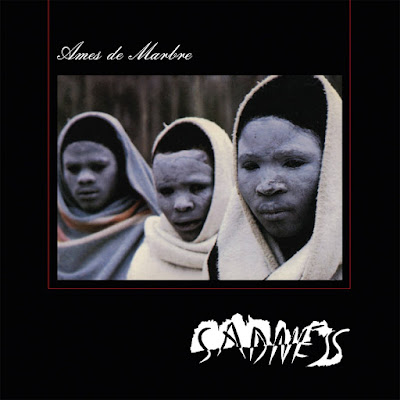
Anti-interview with guitarist Chiva 2018 by Chris Dick...
Sadness was definitely an outlier band in the early ‘90s. What attributed to the group’s diverse approach?
We were four kids wanting to make a powerful band and to play with heart without complicating things with ego. Always playing with our hearts.
But, musically, things were a little clearer, less death metal on Ames De Marbre (compared to the Y and Eodipus demos). What was the motivation to be more adventurous or avant-garde in your approach later on?
Yes, it’s true. There were fewer groups and not many rules or etiquette. The market was good and interesting. Everything is different now. It’s too bad. For us, at that time, things were fast going. I have beautiful memories of this time.
What do you remember about the deal with Witchhunt Records? Must’ve been an exciting time.
The desire to make our music was sincere. Within our universe, in which we found ourselves with our different personalities, we were a simply a real group.
There were troubles labeling Sadness. Some simply called it doom metal, while others added modifiers like avant-garde doom. When you were writing Ames De Marbre, what, if anything was going through your minds as far as definitions or sonic borders?
You know labels. They’re for people who are lost and need a sign. Like children. We knew the image of Sadness. So, yes, we were a little doom, a little death, a little rock…we were simply music. We weren’t lost. Others were. We were not.
What music or bands did you identify with while writing Ames De Marbre?
Joy Division, Christian Death, Bathory, Metallica, W.A.S.P., Celtic Frost, Led Zeppelin, Ozzy, and many smaller bands.
The songs run together. Was the idea to have a continuous story on Ames De Marbre?
It’s true. This album follows a path, a logic. We proposed the direction, the vision, for the listener to have the emotion that they are alone with us. We would never have imagined that the group would interest people. Even less 20 years later. We were playing for our own world not necessarily for others.
The song Red Script still stands out as your most defined and fully realized song. What do you remember about doing Red Script for the full length? Things you did differently for the album version, for example.
Well, just our thing. We were progressing. Red Script was an example of this progression. It was a success on the demo, but the album version was better. It was a good track to end the album with.
Tears Of Sorrow is also quite amazing. The mid-section with the French chorus and the haunting guitar struts. What do you remember about Tears Of Sorrow?
Actually, it was Gradel (drums). The song came about gradually for the album. I worked with him on arrangements on my voice, but I found his direction interesting and creepy. Perfect for this album.
Lyrically, Ames De Marbre is quite gothic, almost Victorian. What was informing your lyric writing at the time? Gradel wrote most of them, right?
We were inspired by many dark and gothic authors from different cultures. And the result was deeply cool.
I recall both Celtic Frost and Samael had difficult times finding a studio and a producer who understood extreme music in Switzerland at the time. Did you find it equally hard to find a suitable place and person to record with? Ames De Marbre was recorded at Studio Syxty. Still sounds fucking great!
The studios were bad for metal. [Most studios] had no experience. The studios that handled metal weren’t interesting to us. Not enough life in them. It took us a long time to find Syxty.
Switzerland hasn’t been the most prolific when it comes to extreme metal, but it’s responsible for some of the most creative: Celtic Frost, Samael, Alastis, Boelzer, Schammasch, and, of course, Sadness. What do you attribute that to?
The good life here in our country [Laughs]. But I don’t know really. We see things in our own way, which is pure and powerful. We all tried to find our own identity, too. We are simply different.
Where did the cover photograph come from? It was striking in 1993. Still striking today.
Everyone talked about the cover. The vision for the cover was to transport souls. The cover photo is effective in doing just that. It’s a win if it still works.
What’s it like to listen to Ames De Marbre 25 years later? Sadness were doing things in 1993 that are now just starting to take flight, like the inclusion of post-punk and coldwave.
Listen, I see all my imperfections in my voice and with my guitar playing, but I do not know that it has something magical. Actually, this is difficult to explain. While Ames De Marbre is immortal, the new groups out there are superior. But if we had continued Sadness, we would be just as professional. That is sure. But life is life. Sadness is no more.
Now that Ames De Marbre is reissued, do you plan to do anything with Sadness? Live shows or a new album?
No. The band stays dead in its magic. Like Bathory or Celtic Frost. And it must remain so. The youth must take our place now.
